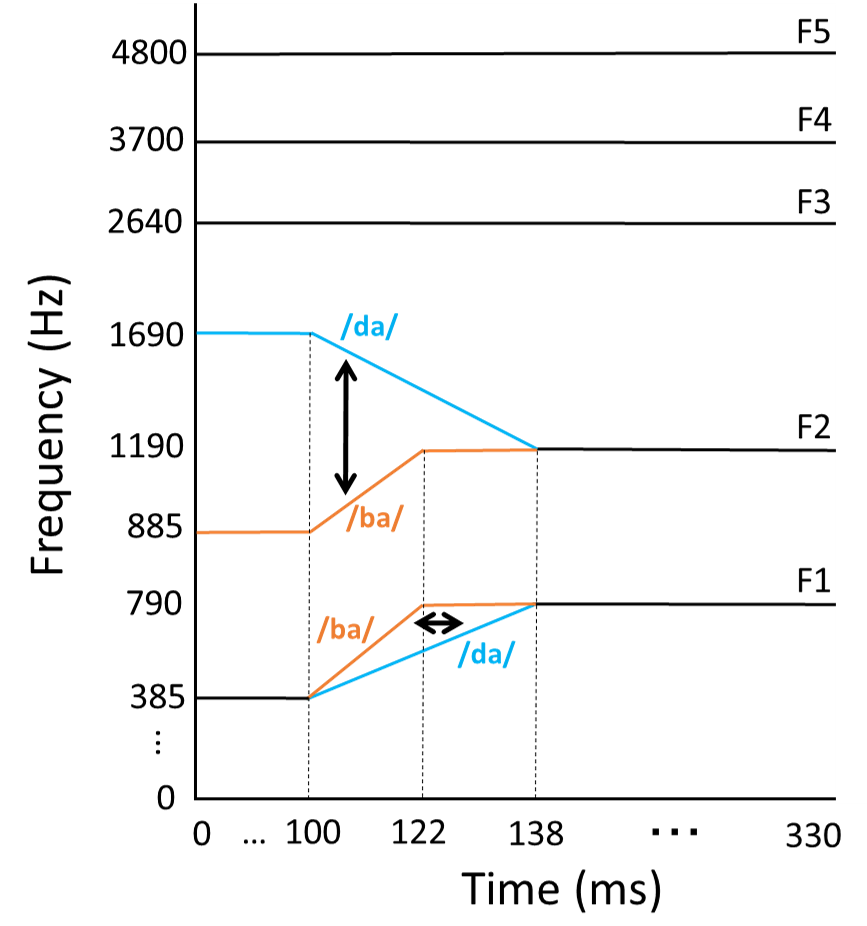As seen in Demo K300, trajectories of the first and the second formant frequencies (F1 and F2) are responsible for the place of articulation of a consonant in a CV (consonant-vowel) syllable.
In this page, we change additional parameters trying to make synthetic CV syllables more natural.

Stimuli in this demonstration are created using a formant synthesizer. Formant trajectories (figure above) and additional parameters (indicated as [new]) are modified as follows. Synthesized stimuli do not have bursts. See [8] Tomaru and Arai (2016) for more details.
[new] ・F1~F3 of the following vowel, /a/:F1=790 Hz、F2=1190 Hz、F3=2640 Hz
・Only F1 and F2 transitions are modified.
[new] ・F1 and F2 transition time: lengthened by 2 ms from 22 ms to 38ms (total = 9 steps)
[new] ・F1 starting frequency:stable at 385 Hz
[new] ・F2 starting frequency: rased by 100 Hz from 885 Hz to 1690 Hz
[new] ・F0 varied as follows
0 ms ~ 100 ms = 125 Hz
150 ms = 130 Hz
200 ms = 135 Hz
300 ms = 130 Hz
330 ms = 125 Hz
[new] ・Bandwidths
F1 = 60 Hz
F2 = 105 Hz
F3 = 150 Hz
F4 = 200 Hz
F5 = 1000 Hz
[new] ・OQ (Open Quotioent: voicing open-time/period) = 80%
[new] ・TL(Extra tilt of voicing spectrum) = 8 dB down @ 3 kHz
| Step 1 | Step 2 | Step 3 | Step 4 | Step 5 | Step 6 | Step 7 | Step 8 | Step 9 | |
|---|---|---|---|---|---|---|---|---|---|
| F1 & F2 transition time (ms) |
22 | 24 | 26 | 28 | 30 | 32 | 34 | 36 | 38 |
| F2 starting frequency (ms) |
885 | 985 | 1085 | 1190 | 1290 | 1390 | 1490 | 1590 | 1690 |
| Sounds |
- Kewley-Port, D., “Measurement of formant transitions in naturally produced stop consonant-vowel syllables,” J. Acoust. Soc. Am., 72(2), 379-389, 1982.
- Kent, R. D. and Read, C., Acoustic Analysis of Speech, Singular Publishing, San Diego, CA, 2001. (荒井隆行, 菅原勉 監訳, 音声の音響分析, 海文堂, 1996.)
- Klatt, D. H. and L. C. Klatt, “Analysis, synthesis, and perception of voice quality variations among female and male talkers,” J. Acoust. Soc. Am., 87, 820–857 (1990).
- Klatt,D. H. “The new MIT speech VAX computer facility,” in Speech Communication Group Working Papers IV, Research Laboratory of Electronics (MIT, Cambridge, MA, 1984), pp. 73–82.
- Liberman, A. M., P. C. Delattre, F. S. Cooper and L. J. Gerstman, “The role of consonant-vowel transitions in the perception of the stop and nasal consonants,” Psychol. Monogr.: Gen. Appl., 68(8), 1–13 (1954).
- Liberman, A. M., K. S. Harris, H. S. Hoffman and B. C. Griffith, “The discrimination of speech sounds within and across phoneme boundaries,” J. Exp. Psychol., 54, 358–368 (1957).
- Liberman, A. M., K. S. Harris, J. A. Kinney and H. Lane, “The discrimination of relative onset-time of the components of certain speech and nonspeech patterns,” J. Exp. Psychol., 61, 379–388 (1961).
- Tomaru, L. and T. Arai, “Role of labeling mediation in speech perception: Evidence from a voiced stop continuum perceived in different surrounding sound contexts,” Acoust. Sci. & Tech., 37(6), 303-314 (2016).